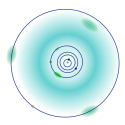| Discovery[1] | |
|---|---|
| Discovered by | 30 October 1999 by LINEAR |
| Discovery site | Socorro |
| Discovery date | 30 October 1999 |
| Designations | |
| 2002 AC180[1] | |
Martian L4  | |
| Orbital characteristics[1] | |
| Epoch 13 January 2016 (JD 2457400.5) | |
| Uncertainty parameter 0 | |
| Observation arc | 21861 days (59.85 yr) |
| Aphelion | 1.5843517 AU (237.01564 Gm) |
| Perihelion | 1.4644704 AU (219.08165 Gm) |
| 1.5244110 AU (228.04864 Gm) | |
| Eccentricity | 0.0393206 |
| 1.88 yr (687.47 d) | |
| 229.9277° | |
| 0° 31m 25.183s / day | |
| Inclination | 16.75044° |
| 347.37714° | |
| 48.35771° | |
| Earth MOID | 0.47372 AU (70.868 Gm) |
| Jupiter MOID | 3.49473 AU (522.804 Gm) |
| Physical characteristics | |
| Dimensions | ~1 km[2] |
| X[3] | |
| 16.9[1] | |
(121514) 1999 UJ7 is a small asteroid orbiting near the L4 point of Mars (60 degrees ahead Mars on its orbit).[2] As of April 2024, it is one of only two known asteroids to orbit the leading L4 point of Mars — the other being 2023 FW14[4] — although at least 15 other asteroids orbit Mars's trailing L5 point: The largest being 5261 Eureka, (101429) 1998 VF31, and 2007 NS2.[2] Not only does (121514) 1999 UJ7 orbit on the other side of Mars from other similar asteroids, its spectrum is different as well, which is puzzling because all of the Martian trojans seem to be in very stable orbits.[3]
- ^ a b c d "JPL Small-Body Database Browser: 121514 (1999 UJ7)". NASA/Jet Propulsion Laboratory. Retrieved 7 April 2016.
- ^ a b c Scholl, H.; Marzari, F.; Tricarico, P. (June 2005). "Dynamics of Mars Trojans" (PDF). Icarus. 175 (2): 397–408. Bibcode:2005Icar..175..397S. doi:10.1016/j.icarus.2005.01.018. Archived from the original (PDF) on 16 February 2012. Retrieved 22 April 2009.
- ^ a b Cite error: The named reference
spectroscopywas invoked but never defined (see the help page). - ^ de la Fuente Marcos, Raúl; de León, Julia; de la Fuente Marcos, Carlos; Alarcon, Miguel R.; Licandro, Javier; Serra-Ricart, Miquel; Geier, Stefan; Cabrera-Lavers, Antonio (21 March 2024). "Dynamics of 2023 FW14, the second L4 Mars trojan, and a physical characterization using the 10.4 m Gran Telescopio Canarias". Astronomy & Astrophysics, Letters to the Editor. 683 (1): L14 (6 pages). arXiv:2403.04061. Bibcode:2024A&A...683L..14D. doi:10.1051/0004-6361/202449688.
{{cite journal}}: CS1 maint: date and year (link)